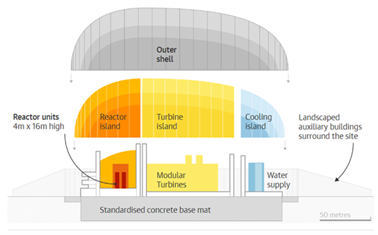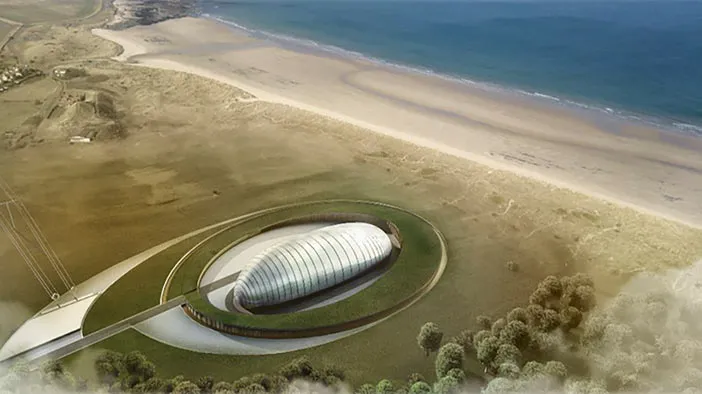There are over 600 large scale nuclear reactors at 435 sites in operation today across over 30 countries. With a combined generating capacity of 345GW, nuclear provides 10-15% of the world’s electricity. To replace the electricity previously generated from burning Russian gas, and to substitute Western-designed nuclear power plants for cancelled Russian ones, Europe would need at least 40GW of new nuclear capacity over the next 15 years. To do so by building large-scale nuclear power plants would be challenging: they have very lengthy construction horizons, costs often spiral out of control, and in recent history they have relied on Chinese or Russian involvement.
Small Modular Reactors (SMRs) are an emerging alternative technology. They promise a dependable source of zero-carbon baseload power. In the UK, Rolls-Royce has developed an SMR design, the US’s NuScale Power is creating another, and there are others. Whilst years from operation, SMRs are garnering increasing interest.

About SMRs
SMRs are defined by the International Atomic Energy Agency as reactors producing less than 300MWe of power. They have a compact footprint, which increases site flexibility and maximises plant locations. The area required is equivalent to around two football pitches – ten per-cent the size of an archetypal nuclear plant.
Rolls-Royce is leading a British consortium which aims to build 16 SMRs. Each is expected to produce between 220MW and 440MW, with the first estimated to cost £2.5bn. For comparison, the conventional Hinkley Point C will produce 3.2GW, equivalent to 7% of the UK’s electricity needs, at a current price of £25bn. The development horizon is broad, however, with the UK government not expecting there to be a functioning reactor until the early 2030s.
Why SMRs are an attractive prospect
- ENERGY SECURITY: The Russia/Ukraine conflict has pushed European governments to accelerate the drive towards domestic energy self-sufficiency. The lower barrier to entry may increase competition and diversify supply chains, reducing dependence on contributions from unpalatable regimes.
- ENERGY MIX: SMRs provide dependable, zero-carbon, baseload power – an alternative to intermittent solar and wind powered generation
- SPEED: SMR’s could be up and running much more rapidly than large scale nuclear power plants – 90% of manufacturing and assembly can be done in factory conditions, and they are based on proven technology.
- SCALEABLE: Modulisation increases production speed, lowers up-front costs and provides scope for incremental additions as and when required.
- UK PLC: SMRs are forecast to create 40,000 regional UK jobs by 2050, with a total economic benefit of over £200b over the next century
The downside risks
- SAFETY: SMRs will require the development of new safety frameworks. They also represent an increased risk of nuclear proliferation, as the reduced lower cost-barrier would mean a larger international market.
- COST: During Rolls-Royce’s November 2021 development funding round, half of the £455m raised came from the public purse. And at $120/MWh (2021 est.), it is substantially more expensive than renewable generation and no cheaper than conventional nuclear.
- NEGATIVE PR: There are negative public fears and concerns about all nuclear power.
- UNPROVEN: Whilst using proven technology, SMRs themselves are in the early stages of development. For Rolls Royce to begin producing SMRs they must gain safety approval, which in the UK will likely not happen until 2026.
Summary
Despite the technology’s potential, SMRs won’t be making a significant contribution to the global energy mix until the 2040s at the earliest. They will bear the same scrutiny as all nuclear power, and so their deployment outside existing nuclear nations may well be curtailed. Compounding this, SMRs are competing against alternative emerging technologies such as green hydrogen – which could represent a more competitive and flexible source of peaking generation capacity.
The pace of their development in the coming decade will determine their ultimate contribution to our future energy supply.


